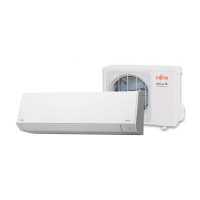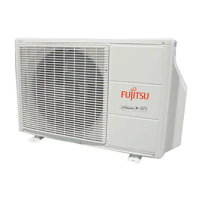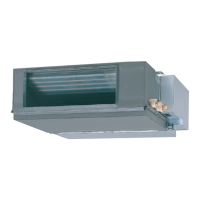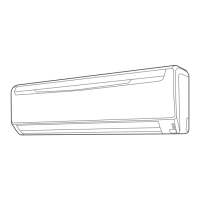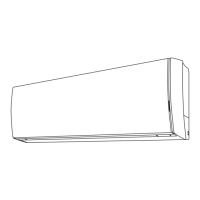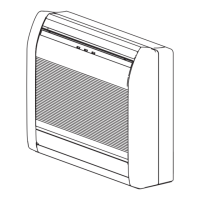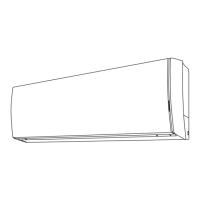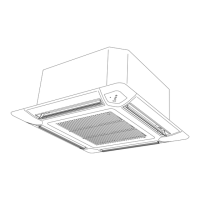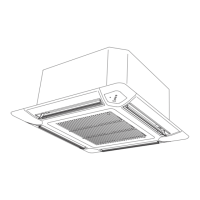En-1PART No. 9320455026
Español
Français
English
AIR CONDITIONER
Wall Mounted Type
OPERATING MANUAL
Before using this product, read these instructions thoroughly and keep this manual for future reference.
Safety Precautions
To prevent personal injury to others, or property damage, read this section carefully before you use this product, and be sure to comply to the
following safety precautions.
Incorrect operation due to failure to follow the instructions may cause harm or damage, the seriousness of which is classifi ed as follows:
WARNING CAUTION
This mark warns of death or serious injury. This mark warns of injury or damage to property.
WARNING
●
Do not attempt to install this air conditioner by yourself.
●
This unit contains no user-serviceable parts. Always consult authorized service personnel for repairs.
●
When moving, consult authorized service personnel for disconnection and installation of the unit.
●
Do not become excessively chilled by staying for lengthy periods in the direct cooling airfl ow.
●
Do not insert anything into the Airfl ow direction.
●
Do not start and stop air conditioner operation by disconnecting the power supply cord.
●
Take care not to damage the power supply cord.
●
If the power supply cord of this appliance is damaged, it should only be replaced by the authorized service personal, since special
purpose tools and specifi ed cord are required.
●
In the event of a malfunction (burning smell, etc.), immediately stop operation, turn off the breaker, and consult authorized service
personnel.
●
In the event of refrigerant leakage, be sure to keep away from fi re or any fl ammables. (consult an authorized service personnel)
CAUTION
●
Provide occasional ventilation during use.
●
Do not direct airfl ow at fi replaces or heating apparatus.
●
Do not climb on, or place objects on, the air conditioner.
●
Do not hang objects from the indoor unit.
●
Do not set fl ower vases or water containers on top of air conditioners.
●
Do not place any other electrical products or household belongings under indoor unit or outdoor unit. Dripping condensation from
the unit might get them wet, and may cause damage or malfunction of your property.
●
Do not expose the air conditioner directly to water.
●
Do not operate the air conditioner with wet hands.
●
Do not pull power supply cord.
●
Turn off power source when not using the unit for extended periods.
●
Check the condition of the installation stand for damage.
●
Do not place animals or plants in the direct path of the airfl ow.
●
Do not drink the water drained from the air conditioner.
●
Do not use in applications involving the storage of foods, plants or animals, precision equipment, or art works.
●
Do not touch the aluminum fi ns of heat exchanger built-in the indoor or outdoor unit to avoid personal injury when you install or
maintain the unit.
●
Connection valves become hot during Heating; handle with care.
●
Do not apply any heavy pressure to radiator fi ns.
●
Operate only with air fi lters installed.
●
Do not block or cover the intake grille and outlet port.
●
Ensure that any electronic equipment is at least 40 in. (1 m) away from either the indoor or outdoor units.
●
Avoid installing the air conditioner near a fi replace or other heating apparatus.
●
When installing the indoor and outdoor unit, take precautions to prevent access to infants.
●
Do not use infl ammable gases near the air conditioner.
●
This appliance is not intended for use by persons (including children) with reduced physical, sensory or mental capabilities, or lack
of experience and knowledge, unless they have been given supervision or instruction concerning use of the appliance by a person
responsible for their safety. Children should be supervised to ensure that they do not play with the appliance.
Contents
Safety Precautions ..........................................................En-1
Indoor Unit Overview and Operations .............................En-2
Remote Controller Overview and Operations ..................En-3
Timer Operation...............................................................En-5
Human Sensor (Energy Saving) ......................................En-7
General Informations on Operation .................................En-7
Cleaning and Care...........................................................En-8
Troubleshooting .............................................................En-10
9320455026_OM.indb 19320455026_OM.indb 1 12/4/2014 5:04:43 PM12/4/2014 5:04:43 PM
